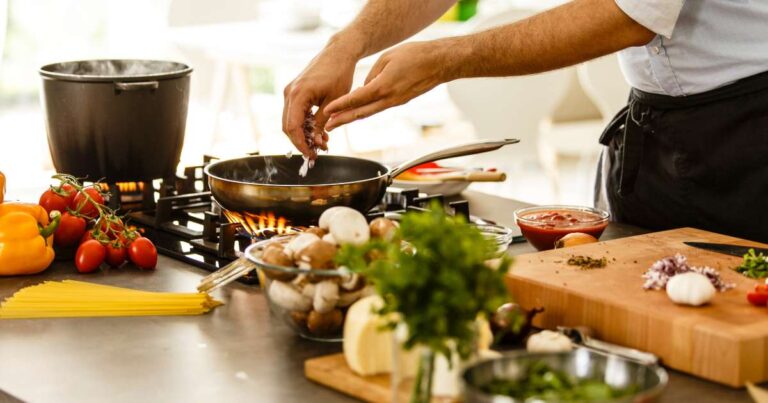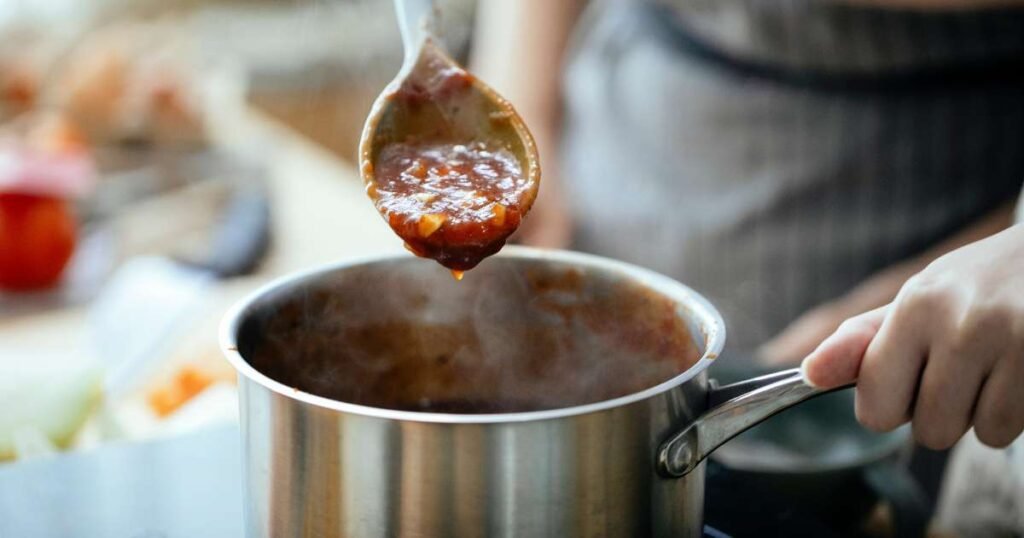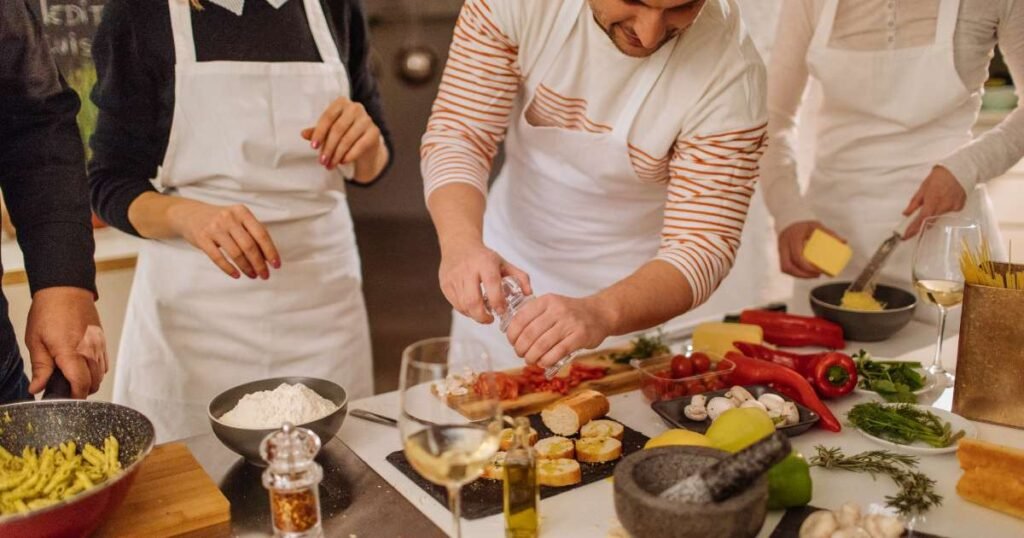
How To Cook Authentic Italian Food Like A Real Italian
From A Clueless American Who Moved To Italy And Re-Learned Everything He Thought He Knew About Italian Cooking
- Nathan Heinrich
- May 2023
- Prosecco Hills, Veneto, Italy
Traditional Italian cuisine is simple and composed of the simplest elements – let’s learn “How To Cook Like A Real Italian”.
A cornerstone of most Italian cooking (the kind of cooking that real Italian grandmothers still practice in Italy) is to always use the freshest seasonal ingredients.
Real, authentic Italian cooking is unpretentious. Italian meals are balanced and healthy.
The modern American or Western-style diet is so far removed from the Italian-style Mediterranean diet that the two are nearly unrecognizable when compared side by side.
However, the good news is that with a basic understanding of ingredients like fresh herbs, vegetables, fruit, fish, meat, and pasta, as well as a few simple spices and extra virgin olive oil, you can transform not only your cooking habits but also your health.

What Real Italian Cooking is NOT
Sometimes understanding what something is not, helps to define what it truly is.
This is especially true when that “something” has been distorted past the point of recognition, the way good Italian food has been in places like the United States.
Many of the “Italian dishes” that appear on Italian restaurant menus and home dinner tables in the United States and other nations are unrecognizable from the traditional Italian food they were supposedly based on.
Somewhere along the journey, that “Italian food” has taken from the perfect sun-dappled views of Italy, to finally arrive on the American shores, it changed drastically.
American-Italian food, unlike its Italian counterparts, is often quite unhealthy.
Chicken In Pasta? Not In Italy!
Creamy chicken Fettuccine Alfredo, big plates of meatballs, endless breadsticks, the bizarre habit of adding parmesan cheese to any vaguely Italian dish – even adding chicken to pasta to “make it healthier” are all things that would make an Italian nonna weep.
Believe it or not, Italians would never dream of making pasta with chicken or practically any other type of fowl.
While one is occasionally able to find an authentic Italian restaurant in places like New York City and Los Angeles, most of the Italian restaurants, especially the chains, serve food that might sort of “look” like Italian food but it couldn’t be further from the real thing.

The Foundation Of Italian Cooking
Cooking like a real Italian does not require an abundance of fancy gadgets.
You will need a good pot for boiling water and making soups, a frying pan, a saucepan, a couple of baking dishes, a colander, a wooden spoon, a cutting board, some sharp knives, an apron (if you’re a sloppy cook like me), and perhaps the most important tool of all – a good nose to tell you when something is cooked to perfection.
Besides the basic cooking tools, proficient Italian home cooks will need to keep several simple ingredients close at hand while cooking.
Italian Extra Virgin Olive Oil
A good Italian extra virgin olive oil, sea salt, red pepper flakes, and fresh herbs like rosemary, basil, oregano, bay laurel, and parsley, as well as some white or red wine to cook with, are some of the most foundational elements found in a well-stocked Italian kitchen.
Simple ingredients, simple pasta, simple pasta sauce, and simple flavors simply prepared, with a bit of Italian bravado, is the best way to execute Italian home cooking.

What Italians Cook
Although classic Italian recipes are rather simple, don’t be fooled, the cooking time is only a fraction of the time that Italians spend getting a typical Italian meal on the table.
Italians spend a lot of time growing fresh produce in vegetable and herb gardens.
For those who don’t have the luxury of their own vegetable garden, scouring weekly farmers’ markets, which are packed full of local produce, is the next best thing.
These fabulous weekly markets pop up in nearly every city and village across Italy and have become part of everyday life for millions of Italians.
The savvy Italian shopper can find a wide range of fresh produce as well as meat and dairy products at these markets.
Producers of extra virgin olive oil, local farms that make parmigiano reggiano and mozzarella cheese, beekeepers who produce pure golden local honey, and farmers who grow everything from tomatoes, zucchini, and eggplant to basil and flat-leaf parsley, bring their goods into town at least once a week so that locals can shop to their heart’s content.
From The Garden Or Weekly Market
Growing and buying fresh produce is merely the first step in the process for Italian cooks – they are also big fans of preservation and canning.
To ensure they are able to cook with the best ingredients all year long, Italians will dry, pickle, and jar everything they are able to.
Marinated “carciofi” (artichoke hearts), tomato paste, roasted peppers, and a range of other delicious creations are examples of preservation that no one does better than the Italians.

How Italians Cook
Almost as important as the type of fresh ingredients Italians cook with is how they are cooked.
Although you may find heavier and creamier dishes in parts of Northern Italy which are highly influenced by Germany, France, and Austria – true Italian cooking is generally lighter and packed full of fresh veggies.
The Italian Mediterranean diet is highly plant-based with the addition of lean proteins like fresh fish and high-quality meat which is raised without most of the unhealthy methods used in American industrial farming.
Simples recipes like “spaghetti alla carbonara” or “spaghetti alla vongole” with the best pasta, cooked “al dente” as a first course, followed by a main dish of wild boar slow-cooked to perfection or fresh-caught branzino, lightly grilled with garlic, parsley, lemon juice, and white wine are examples of the true flavors of Italy.
Italians do not overcook or over-sauce their food.
Italians Cook With Their Nose
One of the most important lessons I learned from Italians when I moved to Italy is to “cook with your nose”.
Whether you’re baking a hearty eggplant parmigiana in the oven or making a pasta sauce on the stove – there comes a point, in the cooking process, when the dish will speak to you through your sense of smell.
I felt discouraged in the beginning thinking “How will I ever know what something is supposed to smell like when it’s done?”.
But I have discovered that, like all things worth having, it takes a bit of time and practice – but not as much as you might think.
By the second or third time you have made a dish, you will have a pretty good sense of when it is “perfetto” – cooked to perfection.

An American Learns To Eat Real Italian Food
Growing up in a 5th generation-farming family in California, we had a big garden and all our neighbors were farmers so there was never any shortage of fresh vegetables in our home.
But what we did with those vegetables would make any Italian home cook lose (his or her) mind.
Homemade Hidden Valley buttermilk ranch dressing was a staple in our home, there was always a large Best Foods brand mayonnaise jar full of it in the fridge – and we loved it.
We poured gallons of it over salads and dipped all sorts of veggies into it.
The veggies we didn’t douse in ranch dressing we slathered in mayonnaise.
To this day, I struggle eating artichokes, asparagus, and broccoli without a large dollop of mayo on the plate to dip each bite into.
It’s not just salads and veggies that are prepared in lighter healthier versions, I have been shocked by the extreme differences in how pasta dishes are made in Italy.
Thinking that Italian food resembled concoctions such as “Fettucine Alfredo”, when I moved to Italy, I was amazed at how sparingly Italians sauced their pasta dishes.
Italian Food Is Extremely Simple
The base of most sauces is usually a simple combination of basic ingredients such as extra-virgin olive oil, garlic, onions, herbs such as parsley or oregano, salt, pepper, tomatoes, or a type of fatty meat that will render its fat to add flavor and body to the sauce.
While Italians use garlic, they use very little just to as subtle flavor to their dishes – often a crushed clove of garlic is removed after it has seasoned the sauce.
The copious amounts of garlic used in American-Italian cooking are repulsive to a native of Italy – too much garlic prevents one from fully enjoying the other flavors of a dish.
As an American who was accustomed to heavy, creamy “garlicy” sauces that smothered a dish of pasta, I have had to adapt my tastes and habits to the delicate flavors and textures that compose a properly-made pasta dish in Italy.
Now that I’ve become accustomed to the real thing, the idea of eating a buttery, creamy, thickly-sauced dish of “pasta” from an American Italian restaurant chain is unthinkable.
Light Dressings And Sauces
Italians enjoy a healthy garden-grown salad as much as anyone, but the way they dress their salads is unrecognizable from the way we Americans dress ours.
A simple blend of a few tablespoons of extra virgin olive oil and some vinegar or lemon juice with a pinch of salt is the only thing Italians dress their salads with.
The amazing thing that happens is that you can actually taste the delicate, complex flavors of vegetables when you eat a salad this way.
Many Americans, myself included, forgot or never even knew what fresh veggies were supposed to taste like because our tastebuds have been trained to associate the taste of vegetables and salads with the flavor of processed dressings and sauces.
If you’re thinking to yourself, “How will I ever be able to cook and eat like a real Italian?
I can’t move to Italy or even take cooking classes from real Italians in Italy” – well you’re in luck.
Italian Cooks On TV
There are some excellent real Italian cooks on TV and Instagram that I personally love and whom you should consider following.
One of the very best Italian cooks with her own TV show, cookbooks, and even her own restaurants is Lidia Bastianich.
Another wonderful Italian cook with his own cookbook and a fabulous Instagram page is Gennaro Contaldo.
And one of my all-time favorites is the incomparable “Pasta Queen” herself, Nadia Caterina Munno – not only will she make you laugh she will also teach you to cook at the same time.
Search YouTube for some of the best Italian chefs who don’t even speak English.
One of my personal favorite Italian chefs in Italy is Carlo Cracco. Chef Cracco is also the host of the Italian Show Dinner Club on Amazon Prime.
You will be amazed at how easy it is to follow along with what Italian chefs are communicating in spite of the fact that you may not understand every word they are saying.
Cooking With The Seasons
Another lovely thing that Italians do is to cook with the seasons.
Whatever happens to be ripe during any given month is what will end up on the plates in Italian homes and restaurants.
With a base made using a bit of trusty olive oil and the holy trinity of onions, carrots, and celery the most delicious bean and vegetable soups are made during the fall and winter months in Italy.
Baking during the winter months will usually include citrus fruits which are in season during this period.
While in early spring, you will find peas and asparagus popping up in many Italian dishes.
Summer, of course, is blessed with an abundance of tomatoes, cucumbers, eggplants, peppers, zucchini, beans, and a wide range of other fruits, herbs, and veggies – many of which are enjoyed fresh while others like homemade tomato sauce are canned and preserved to be consumed during months when these items are out of season.
Don't Stress About Getting It Perfect
I’ve lived in Italy since 2020, and I am nowhere near where I’d like to be with my Italian cooking abilities – and I’m learning to be ok with that. Don’t be too hard on yourself if you don’t know the first thing about how to cook like a real Italian. We all have to start somewhere.
Watch Italians cook on YouTube – the best ones don’t even speak English which makes the whole process even more delightful because to learn to cook proper Italian food you don’t need to understand the language, you simply need to watch and repeat.
Enjoy the process of learning and focus on mastering a single dish at a time.
Start by replacing your store-bought salad dressings with a small amount of olive oil, lemon, a few fresh herbs, and salt mixed in a little bowl and poured over your salad greens – slowly taste each bite and experience the subtle flavors of each vegetable.
Buon appetito!
Disclosure: Here at All Roads Lead To Italy, we only recommend products we would use ourselves and all opinions expressed here are our own. This post may contain affiliate links with potential savings at no additional cost to you. In some cases, we may earn a small commission. Read our privacy policy for full details.


Dreaming of Moving to Italy?🇮🇹 - Get this FREE podcast & be INSPIRED by someone who moved from New York to Italy in 2020!
*By signing up for this Podcast you’ll also be joining our mailing list through which we will keep you up to date on all things Italian! We never sell your information and you can easily unsubscribe at any time.
Share This Post
Author Info:

Nathan Heinrich
Nathan is a writer, designer & horticulturist. He is the founder and Editor-in-Chief of "All Roads Lead to Italy" Magazine & host of the Top-10 Travel Podcast, "I'm Moving To Italy!". Nathan was born and raised in a 6th generation farming family in Northern California, he is currently, a dual Italian citizen, living in the Prosecco Valley of Northern Italy, near Venice.

